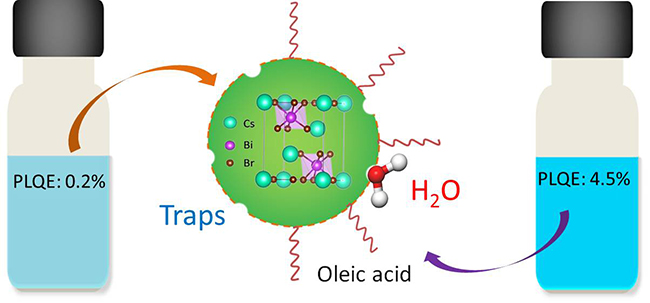
Scientists HAN Keli et al. from Dalian Institute of Chemical Physics (DICP) of the Chinese Academy of Sciences (CAS), synthesized a new lead-free Cs3Bi2Br9 nanocrystal (NC) and revealed the photophysical mechanism of it. The results were published in Angew. Chem. Int. Ed. (DOI: 10.1002/anie.201704739)

PLQE can be increased from 0.2% to 4.5% when oleic acid is added during the synthesis processes (Image by YANG Bin)
Lead-based perovskite NCs with formula APbX3 (A: Cs, CH3NH3 (MA), X=Cl, Br, I) have received broad attentions for their excellent optical and electronic properties.
The perovskite nanostructures have high PL quantum efficiency (PLQE), large absorption cross-section, low-threshold for lasing, and tunable PL emission in the whole UV-Vis range due to the quantum confinement. However, the toxic of lead-based materials pose a threat to the environment and humankind.
Furthermore, the application of perovskite NCs is still limited by their instability in air. Thus, searching for low toxic and highly stable perovskite NCs is on the cutting-edge of the research.
Scientists found that the PLQE can be increased from 0.2% to 4.5 % when oleic acid is added during the synthesis processes. They have determined that this improvement stems from the passivation of fast trapping process which is 2~20 ps.
Notably, the trap-states could also be passivated in humid condition and the NCs exhibited high stability towards air exposure exceeding 30 days.

86-10-68597521 (day)
86-10-68597289 (night)

86-10-68511095 (day)
86-10-68512458 (night)

cas_en@cas.cn

52 Sanlihe Rd., Xicheng District,
Beijing, China (100864)

